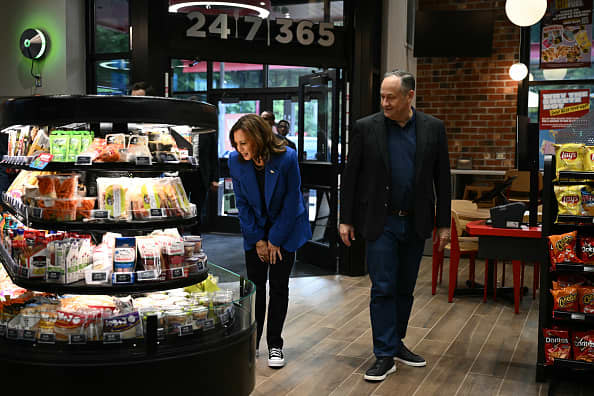In the heart of the presidential debate, a pressing issue has emerged: the rising costs of groceries and everyday essentials. As the 2024 election approaches, Democratic presidential nominee Kamala Harris has taken center stage with an ambitious economic plan aimed at addressing these concerns. During a recent stop at a Sheetz gas station in Coraopolis, Pennsylvania, Harris unveiled her strategy, which includes a commitment to combat price gouging and provide relief to consumers burdened by escalating grocery prices.
Harris’s proposed federal ban on price gouging first made headlines in mid-August, drawing sharp criticism from former President Donald Trump, who labeled the initiative as “Soviet-style” price controls. Nevertheless, Harris’s campaign has emphasized the need for regulations that prevent corporations from exploiting consumers during crises. In her comprehensive 82-page economic plan, the Harris-Walz campaign outlined intentions to establish clear guidelines that would protect consumers from excessive price hikes, particularly in the food sector.
This focus on grocery costs comes at a time when inflation and rising prices have become hot-button topics for voters across the nation. According to a recent poll conducted by The Economist/YouGov, a significant 60% of adult U.S. citizens support capping increases on food and grocery prices, reflecting widespread frustration with escalating bills. While the Bureau of Labor Statistics reported only a 1% increase in food prices over the past year, groceries remain 25% more expensive than they were in August 2019, underscoring the persistent financial strain on American households.
The debate over rising prices is complex, often clouded by differing definitions of what constitutes price gouging. Rakeen Mabud, chief economist at the progressive think tank Groundwork Collaborative, highlighted two main interpretations: one technical, which pertains to emergency situations, and another more subjective view that condemns companies for charging unfair prices simply because they can. With 37 states already possessing laws against price gouging during emergencies, the challenge lies in defining and regulating the practice in broader contexts.
The narrative of “greedflation” has also gained traction, attributing rising prices to corporate greed rather than supply chain disruptions or labor shortages. A study from the Federal Reserve Bank of Kansas City indicated that increased markups have significantly contributed to inflation. However, many economists, including Fed Chair Jerome Powell, assert that the inflationary pressures stem from a combination of factors, such as labor market tightness and ongoing supply chain challenges.
The grocery industry has pushed back against accusations of price gouging, with industry leaders arguing that rising costs are a reflection of complex economic realities rather than corporate malfeasance. Sarah Gallo, senior vice president of the Consumer Brands Association, emphasized the need for clarity in discussions about pricing, pointing out that many factors influence costs, from labor to transportation. Retail executives, like Target CEO Brian Cornell, echo this sentiment, arguing that retailers risk losing customers if they inflate prices excessively.
However, there are indicators that consumer preferences are shifting in response to rising costs. Jharonne Martis, director of consumer research at LSEG, has noted that some companies, like Kroger and Procter & Gamble, are experiencing higher gross profit margins compared to pre-pandemic levels. This development raises questions about the sustainability of price increases in an environment where consumers are increasingly opting for less expensive alternatives.
As consumer frustration mounts, major retailers are taking notice. Walmart, the nation’s largest grocer, has announced measures to combat vendor price hikes, aiming to stabilize costs for shoppers. The company’s CEO, Doug McMillon, stressed the importance of keeping prices in check, acknowledging that inflation persists in certain grocery aisles.
To counter the impact of inflation and shifting consumer behavior, many food companies are reintroducing discounts and promotions that had been curtailed during the pandemic. As shoppers adjust their purchasing habits, companies are feeling the pressure to respond. For instance, J.M. Smucker’s vice president of sales indicated that the food company is passing on commodity relief to consumers when feasible, though price hikes are still planned in response to rising costs.
The road ahead for Harris’s proposed price-gouging legislation remains uncertain. While the idea of capping prices resonates with many voters, implementing such policies in Congress may prove challenging. Economic analysts, like Arun Sundaram from CFRA Research, caution that the multitude of factors contributing to inflation makes it unlikely that any administration can offer quick solutions.
Ultimately, the discourse surrounding grocery prices and inflation will likely continue to evolve as the election approaches. Voters are left to ponder the role of government in regulating corporate pricing practices, the influence of consumer choice, and the intricate web of economic factors that contribute to their daily expenses. As both Harris and Trump outline their strategies to combat inflation, the electorate will have to weigh the potential impacts and effectiveness of these proposals on their wallets.

